Lesson
News / Blog
Other Menus
Seasonal Kakejiku
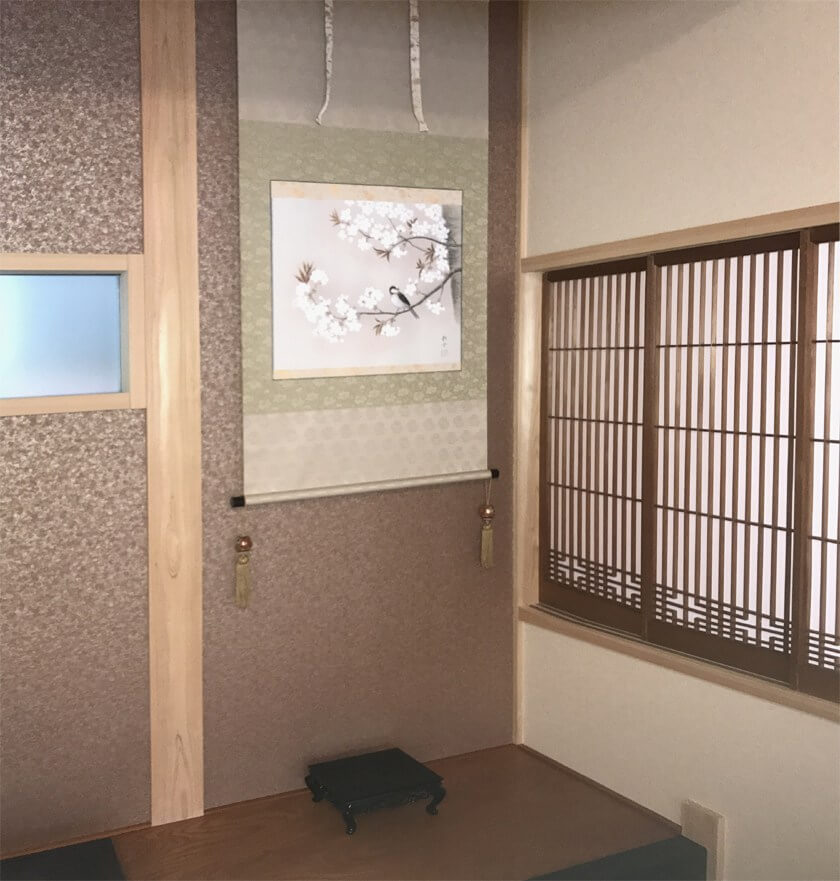
There are four seasons in Japan and artists have been embodying the beauties of nature in their artifacts from ancient times. Admiring the seasons is innate in sentiments of the Japanese.
As for kakejiku, most of customers obtain kakejikus associated with four seasons one after another once they collected usual kakejiku, auspicious kakejiku, and Buddhist kakejiku the so-called ‘Three Sacred Treasures’ so that they appreciate each season.
Even supposing four seasons in Japan to be spring, summer, autumn, and winter, to be precise there are passages of those seasons that diversify seasonal kakejiku.
Generally, as a custom, a seasonal kakejiku is displayed a little before the season whose motif is seen in real life and is exchanged to the other one before the subject is out of the height of its season.
This time, I will talk about the appropriate seasonal kakejiku to display at each time of a year, from New Year to the end of the year. – Only as an example.
From January to Around the Mid-February
The kakejiku replaces an auspicious kakejiku after New Year is generally called ‘Fuyugake /winter kakejiku’.
Nandina
I would say ‘nandina’ is the mainstream fuyugake. The motif is not flowers but red berries whose red color is thought to repel evils from old times and the kakejiku began to be used for auspicious occasions by the end of the Edo period.
The motif is regularly depicted in combination with the adonis to pun on a saying ‘A trouble turns into a happiness’ (Trouble =Nan= Nanten/Nandina, Happiness=Fuku =Fukujyusō/Adonis ) and that boosted the popularity of the subject which was recognized as something auspicious.
Snow is also often portrayed with the nandina since the Japanese suppose a combination of red and white is fortunate.
Snowscape
Kakejiku with snowscape motif is also one of the kakejikus commonly displayed and they can be either a sansui-ga or a picturesque snowscape of a place of interest. Especially those of shrines and temples with absolute beauty have been a favored motif by artists from long ago. – For instance, the snowscape of the Kinkakuji temple.
Intriguing enough, snowy scenery with a dynamic depiction of snow tends to deter residents who live in an area of heavy snowfall as the burden when coping with the snow is imprinted on their mind, snow isn’t really something to lift their spirits.
I found it interesting that in fact, preference in subjects of painting varies regionally.
Camellia
The time the camellia blooms very much differs depending on the cultivars yet generally kakejikus with the motif are put on a show from winter to spring considering the time is their flowering time.
The flower is said to be beloved the most by Sen no Rikyū, the celebrated tea master and as around winter, ro no kisetsu/November to April, tea rooms are filled with the flower, it is also known as ‘The queen of the flowers for a tea ceremony.’
The breeding of the camellia has a long history and because the flower was cherished by the general of Edo, feudal lords of the Higo, the Kaga provinces, and so forth as well as court noble of Kyoto, it also greatly caught on among the common people enough to produce its new varieties. The introduction of the plant to Western countries was such a success. It was well-received due to its feature of being evergreen and capability of blooming in the shade and new varieties of the camellia that bloom glamorous flowers were produced based on the Western aesthetic sense. The flower is beloved in Europe, the U.K., and the U.S., so numerous new varieties have still been being bred.
Winter-Flowering Peony
The peony is an early summer bloomer, still ‘winter-flowering Peony’ was born by the enthusiastic long-time breeding for enjoyment during the winter.
From the ancient time, the peony has been an incredibly gracious flower and even considered as ‘the king of flowers’ in China. The Japanese shared the thought and many of the nations have been found of the flower. Such peony was born answering the wish of predecessors which is to appreciate the flower not only in early summer but wintertime.
In almost all these depictions, a peony is under an umbrella made of straw. I would imagine without it, it can be rather tricky to distinguish if the peony is the usual one or the winter-flowering one. The look of the snow which seems to pile up on the umbrella is adding a good ambience to the artwork.
Narcissus
Chinese classics said ‘Hermit who exists in heaven is heavenly immortal, on earth is earthly immortal and in water is water immortal’ (Water immortal in Japanese is Suisen/Narcissus). Suisen is supposedly named after the meanings of growing by the waterside, having a long lifespan, and being immaculate like a hermit. Possessing the fragrant aroma and beauty, the narcissus is a favored motif of winter for many Japanese‐style painters.
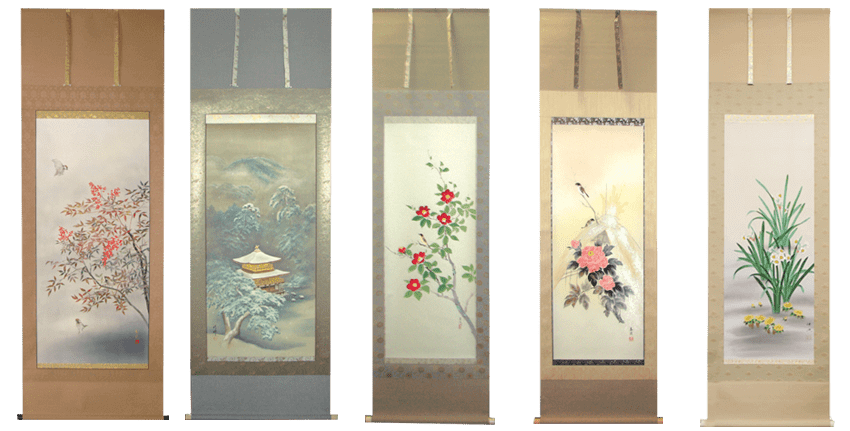
From Around the Mid-February to Around the Mid-March
Winter chill is gradually easing off and it is the time to prepare for the arrival of spring so don’t leave ‘Fuyugake’ displayed and let’s move on.
Plum Blossoms
I would recommend putting on a show a kakejiku with a ‘plum blossoms’ motif at the transition time from winter to spring I mentioned above. As I previously introduced on the pages of ‘Usual kakejiku’ and ‘Auspicious kakejiku’, in China since ancient times, the plum tree has been considered as the first tree to blossom in spring after going through winter, the season when plants and flowers wilt. Because of the trait, the plum tree is believed to be something fortunate and also the symbol of vitality and for that reason, quite a few artists have left their masterpiece with the subject.
As a lucky combination of red and white, a motif portraying both red and white plum blossoms is supposed to be even more auspicious.
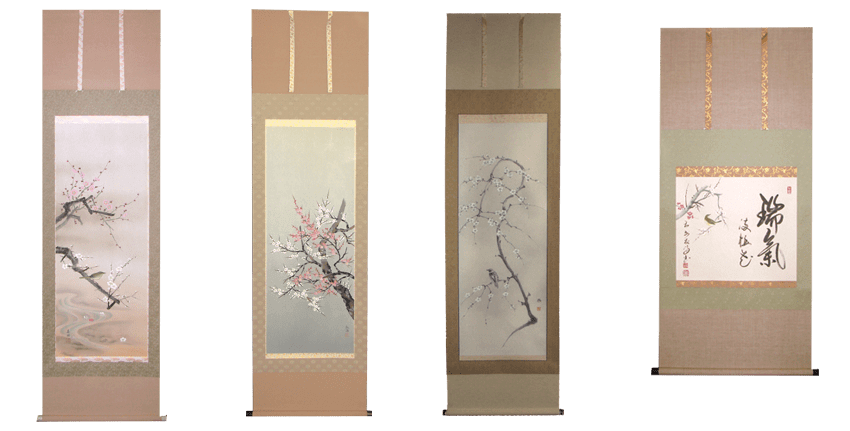
From Around the Mid-March to Around the Mid-April
Finally, the spring has come when the season of plum blossoms has been over. As for springtime, ‘cherry blossoms’ the iconic flower of Japan is the representative motif. Even so, let’s look into the alternatives too.
Cherry Blossoms
Needless to say, ‘cherry blossoms’ is the symbolic flower of Japan. I would like you to enjoy the kakejiku, the representative for ‘Harugake/spring kakejiku’, by displaying one of those at your alcove, feeling the joyfulness of a cherry blossom viewing.
As an old Chinese poem refers to ‘a moment of time in a spring evening is worth a thousand pieces of gold’ cherry blossoms seen at the evening time has its exquisiteness on a whole different level.
This ‘yozakura / cherry blossoms at night’ is another good motif you could feel an air of the spring contentedly.
Magnolia
The blooming season of the flower coincides with cherry blossoms’. The view of the large purple flowers proudly blooming looks absolutely amazing that you would go so far as to feel their dignity. From old times, the magnolia has been a popular motif to express springtime as with its white variety.
Others
The motif for this season is predominantly cherry blossoms and the lone and possible candidate is the magnolia. Nevertheless, it doesn’t mean that other subjects have never been drawn.
For example, the Japanese rose and the Japanese quince are the other motifs that have been portrayed.
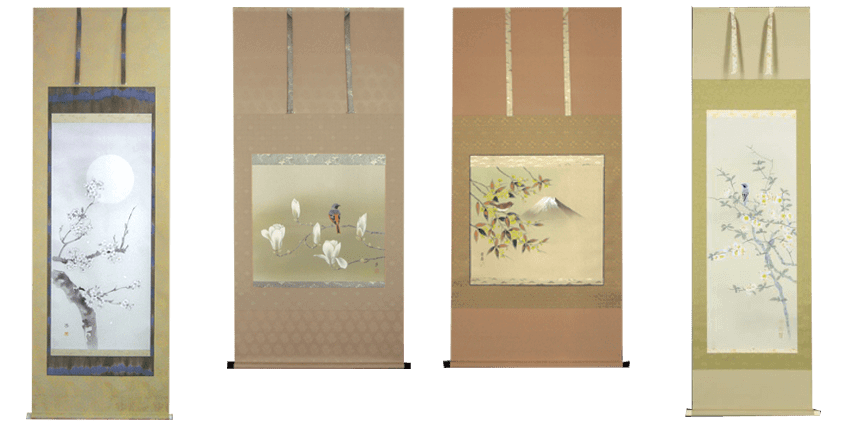
From Around the Mid-April to Around the End of May / By Rainy Season
When the season of cherry blossoms ends, it turns to a comfortable time of year with a moderate climate. I would like to introduce displayable kakejikus for this period, from early summer to rainy season.
The Peony
The peony ‘the king of flowers’ represents early summer, this time of year. The large flower is striking enough to please the eye for many of us.
The well-drawn subject has been also a top-rated motif among Japanese-style paintings depicting flowers and birds. – I’d say, in the same position of cherry/plum blossoms and autumn leaves.
The peony which deserves to be called the king of flowers, rich in an ultimate gracious atmosphere must titillate the motivation of artists.
The red and white flower portrayed together in combination is often seen as well.
Well, I don’t know where this arrangement comes from but in the field of kakejiku, it is said that the peony as a motif is allowed to display regardless of the season given that it is the supreme flower with an implication of entertaining guests in the best possible way.
This is rather exceptional as an arrangement therefore, not many people know about it. Still interestingly, on certain occasions through my job, I met someone who mentioned the principle. – I will try hard to find out the source of this exemption..!
Japanese Iris
‘Japanese iris’ is another motif displayable around this time of year. Having a name Shōbu in Japanese punning on ‘victory or defeat’ and leaves with a sharp apex, the flower was believed to ward off evil spirits and bring good fortune. Kakejikus with the motif is commonly put on a show at the Boys’ Festival wishing for the healthy growth and happiness of boys. – when particularly designed for the Boys’ Festival, in many cases the flower is portrayed together with a kabuto helmet.
-min.png)
Around June / Rainy Season
When early summer ends the muggy rainy season sets in. Even this depressing period can be turned into pleasure by exchanging kakejikus. I’m going to introduce kakejikus delightful particularly for this time of year.
Hydrangea
‘Hydrangea’ represents flowers that delight the eye during the rainy season. Their characteristic of being multicolored and growing densely makes them look absolutely gorgeous.
In old times, even the legendary artist Itō Jakuchū drew the flower along with chickens with the title ‘Ajisai Sōkei-zu / Rooster and Hen with Hydrangeas’.
Hollyhock
‘Hollyhock’ the flower of a stately plant that grows up to 1~3meters high upright is another enjoyable motif during this period. The flower is also called ‘Tsuyuaoi / rainy season aoi’ since it blooms at the beginning of the rainy season then ends its flowering season at the end of the season-when the blooming part reaches the top of the scape. The flower is perfectly entitled to be the flower of the rainy season.
The flower drawn by Sakai Hōitsu the founder of the Rinpa School in Edo is particularly famous.
-min.png)
From July to the Early August / By Obon Festival
The rainy season has gone and at last, the summer has come. Since the feeling of temperature during the summer in Japan is extremely high, thanks to the sticky climate, I’ve been nagged by foreigners saying ‘it’s unbearably hot!’…wry smile.
In that boiling hot summer, our desire to feel any cooler has never changed since the old days. I’m now happy to introduce ‘Natsugake / summer kakejiku’ with the feeling of coolness.
Morning Glory
‘Morning glory’ is on the top list of the flowers representing Japanese summer which also is a graceful reminder of the summer in Japan.
An atmospheric scene of the flower blooming one by one in the morning mist in summer has been admired by the Japanese for a long time. In the past, the flower became a growing trend in two different occasions in the Edo period and that pushed forward the breeding of its foliage plant variety.
Although the flower’s inevitable color is blue, purple and white ones are frequently portrayed and the look of them in different colors, scattered rhythmically in a painting is for me entertaining enough.
Sweetfish
Sweetfishes swimming in schools feeling the coolness of the water is a favored image of the summer. The visual aspect of them swimming playfully in a mountain stream and bringing about coolness is also pleasurable as a seasonal kakejiku for summer.
The fish is popular as food too and since the season of the fish, especially for natural ones, is limited, it is known as the taste of early summer.
Kingfisher
A popular bird for its splendid look which is even admired as a ‘living jewelry’ after its gorgeously colored feather.
This is not a creature implying a particular season. Even so, the bird is generally painted as a motif of summer due to its very much cooling appearance, having feathers in vivid blue and seen in a waterside.
Besides, the bird is thought to be an auspicious bird which fulfills personal prayers because of its sharp beak, able to catch the prey unfailingly.
Others
The above-mentioned kakejikus are quintessential kakejikus for summer. Nonetheless, there are various kakejikus alternatively displayed with the motifs such as lily, dayflower, and goldfish.
-min.png)
From the End of August / After Obon to the End of September / the Mid-Autumn
The lingering summer heat is still with us when obon is over though, in kakejiku’s circles, it’s about time we prepare for autumn.
A long Japanese autumn has the periods of early autumn, mid-autumn, and late autumn and that diversified the autumn kakejiku.
To start with, I am going to introduce ‘Akigake’the kakejiku to be displayed around early autumn.
Chinese Bellflower
Despite its impression of being an autumn flower, its actual blooming season is from the rainy season, the mid-June, continues throughout summer up to around September, the early autumn.
The fact that it is one of the seven flowers of autumn could have been misleading.
The flower has been cherished by the Japanese from long ago for its star-shaped flower modestly and elegantly opens. It especially caught on among samurais (warriors) for its radicals of Chinese character which can be read as ‘Even greater’ and for that reason, it was integrated into their family crest and even used as a room name ‘the Chinese bellflower chamber’.
I strongly recommend you to display a kakejiku with a Chinese bellflower motif for taking delight in the height of the season.
Chrysanthemum
Chōyō no sekku, the last one of the five seasonal festivals in Japan used to be hold according to the lunar calendar and in the season the celebration held, the flower was in full bloom therefore the festival was also called as ‘Chrysanthemum festival’.
At this celebration, the flower was decorated and alcoholic drinks on which petals of it were floating were served, wishing for longevity whilst expelling evil.
Based on the solar calendar, Chōyō no sekku takes place on the 9th of September slightly earlier than it used to be today. Even so, I suggest you displaying and enjoying the kakejiku with the chrysanthemum painting in this period.
Being recognized as the Japanese imperial crest, the flower gives us such a noble impression and that explains why the flower historically has been desirable as a motif for a great number of painters competing in the skill of the depiction with one another.
Autumn Flowers
The symbolic flowers of autumn are called akinonanakusa / seven autumn flowers – bush clover, Japanese pampas grass, kudzu, pink, patrinia scabiosaefolia, thoroughwort, and Chinese bellflower. The motif can be a portrayal of a single flower, a combination of 3 or 4, and all of those. From old-time, having the various combinations of the flowers, the subject has been favorable for painters.
Although it is not a motif limitedly available for this season, providing it includes the Chinese bellflower, I would like you to display the kakejiku on this time of year.
~9月末頃まで(仲秋)-min.png)
From October to the End of November
Around this time, when autumn is on its way, our chances of fun seasonal outing activities increase under a comfortable climate.
Therefore, in Japan, many aspects such as ‘reading book’, ’appetite’, and ‘sports’ can be linked with the season.
As we all know ‘art’ also ties in autumn. I’m sure that the comfortable season with the gift of a vivid colored nature has been such an inspiration for artists since ancient times. A great number of masterpieces with an autumn scheme have been created.
Now then, let me introduce kakejikus for this season.
Autumn Leaves
There is even a phrase ‘the object for spring is cherry blossoms, for autumn is autumn leaves’ and it is the feature of the autumnal season in Japan which decorates the time of year beautifully. It’s the longer height of the season in comparison to cherry blossoms’ may well be another likable factor.
The irresistible motif of the leaves in bright red and yellow is grabbing enough to ignite the professional mind of artists.
Autumn leaves are at their best for a long while therefore the motif is often displayed in admiration from this time and all the way to the end of autumn.
Persimmon
Persimmon is one of those motifs representing autumn. During this season, the trees bearing orange-colored fruits are seen all over Japan and their vivid color has made them popular as a subject.
The motif is also thought to be auspicious due to the name in Japanese ‘kaki’ as the phonetic equivalent Chinese characters mean ‘delight comes’.
Ear of Rice Plant
This time of year is the harvest season for farmers and for the Japanese it is also the time of thanksgiving to the God for their autumn harvest. A Japanese tradition, carrying a portable shrine at a festival, shares the same root of appreciative thought.
Therefore, many paintings of the ear of rice plants have been drawn contrary to what you might think.
The kakejiku will surely entertain you as the symbol of autumn.

December
In late autumn, the time autumn finally drew to a close, we are flustered being swamped with the preparations for the winter as well as the year-end and New Year. This period is called ‘shiwasu / a master runs’ which sounds just spot on.
In such a season, quite a few of us leave kakejikus whose motif is autumn leaves or persimmon displayed until December.
Yet still, there has been an inquiry which is ‘Is there any kakejiku we can enjoy exclusively during late autumn?’ so I am introducing kakejikus that will be the answer for the query.
Sasanqua
This time of year, autumn leaves on flatlands are nearing their end. Sasanqua is the flower enjoyable around the time. Its somewhat sorrowful but innocent ambience is loved by the Japanese so much that it has been established the status of a foliage plant.
The kakejiku with the beloved motif will light up this flowerless season.
Snake Gourd
The fruit in either orange or vermilion, ripens in late autumn is chosen as a motif from time to time. It is also utilized as ornaments in recent years.
The kakejiku is one of the rare choices available to put on a show in late autumn.
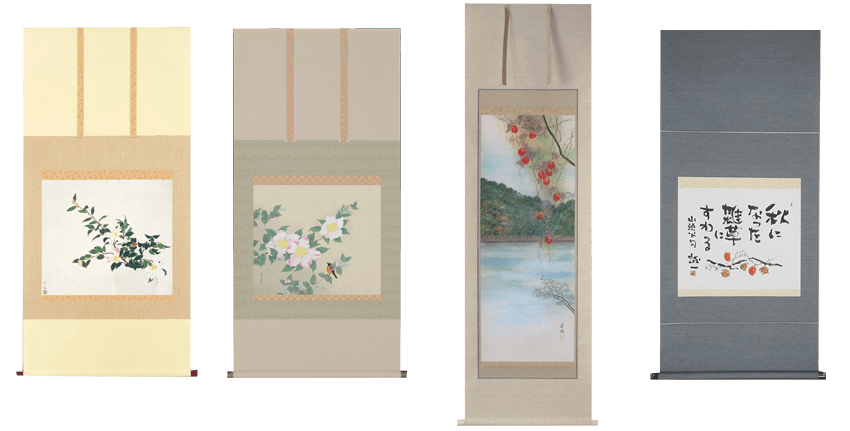
Summary
I hope you find this article helpful.
That is all for the transition of the appropriate seasonal kakejiku for each period from New Year to year-end.
Since they are only the mainstream among all, there are a variety of seasonal kakejikus that haven’t been featured this time. Nonetheless, having some idea of the major ones would help you for a better understanding.
When the late autumn comes to an end in December, we greet the New Year, the beginning of a brand new year displaying an auspicious kakejiku.
I would be grateful if you would collect the kakejiku for each season stepwise and enjoy yourself over them.

